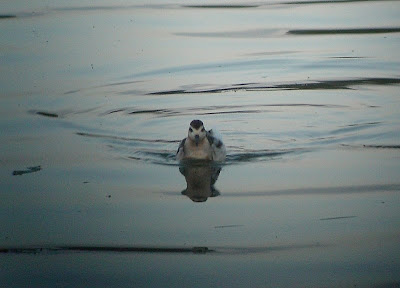With the news that 2 Grey Phalaropes had been found at Weston Turville Reservoir in Bucks I quickly contacted Roy Rose with the news, eager to see them Roy left Theale, Berks and made his way over to me. As I waited for Roy to arrive news broke that the adult Grey Phalarope had flown off at 18:07 heading off in an north easterly direction, perhaps heading to Wilstone Reservoir?. It will be interesting to know if it's found there tomorrow.
Roy picked me up and we headed off to Weston Turville arriving at 19:30 with the hope that the Juvenile would still be present. After being informed the juvenile was still present we hurried along the path and up the bank at the dam end of the reservoir, we were greeted by large numbers of both Swallow and House Martin feeding over the lake. The juvenile Grey Phalarope was in the north west corner, 50ft off the bank feeding on the waters surface and I had just enough time to view it through my binoculars before the bird flew off towards the eastern side of the reservoir. It soon returned and fed below us giving great views just metres away from the edge of the reservoir. By now the light was fading and digiscoping the Phalarope became very difficult in fading light and the fact the bird didn't sit still for a second made it even harder, I did manage to grab a few shots and then decided to try and film it using my camera and my scope, not great results but better than I expected.
The Phalarope species is one of my favourite bird families, often tame and very approachable giving incredible views, a very charismatic wader. The Grey Phalarope feeds mainly on insects which it takes from the waters surface while swimming in circles, it will also feed on crustaceans, molluscs, worms and other aquatic creatures whilst on it's breeding grounds and in winter it eats marine plankton picked from the sea's surface. This Arctic-breeding wader winters at sea with many birds wintering off the west coast of Africa, they have the ability to spend months on the sea, miles from land which is remarkable considering their small size. Like the other Phalarope species, the female is the more colourful of the two and leaves the male to incubate the eggs and bring up the young, once she has laid her eggs she begins her southward migration. The young mainly feed themselves and are able to fly within 18 days of birth.
Added To My Year List.
204. Grey Phalarope
Grey Phalarope



No comments:
Post a Comment